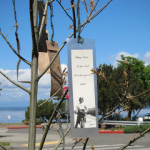Today’s post was submitted by Kent Peterson of Issaquah. You can follow Kent’s bicycle adventures on his blog–aptly named–Kent’s Bike Blog.
Rumble strips are those milled lines at the edge of the road designed to alert a drowsy or inattentive driver that they are drifting off the road. It’s a safety mechanism designed to save lives. Unfortunately, in many locations when rumble strips are placed on the road they effectively make it impossible to safely cycle along the shoulder of the road. In my tour of Washington State a few years ago I’d often see rumble strips that looked like this:
| Photo by Kent Peterson. |
I’ve seen worse examples, where the rumble strip covers every inch of the width of the shoulder. But things don’t have to be this way.
Rumble strips can be built into a road in a way that lets them serve their warning function and keeps the almost the entire width of the shoulder usable for cyclists. Here is a photo from a section of SR-507, also in Washington State:
| Photo by Kent Peterson. |
The rumble strips on SR-507 are built into the fog and center lines, effectively leaving the full width of the shoulder available to the cyclist. In addition, every dozen feet or so there are gaps in the rumble strips enabling cyclists to move from the shoulder to the traffic lane. Much of the time on a country road like this, the shoulder is the best place to ride, but a cyclist might have to merge into the traffic lane to get ready to make a left turn or to avoid some debris and it’s good to see a road design that recognizes the legitimate needs of non-motorized road users.
Rumble strips can be done right. A page at http://www.rumblestrips.com/ (yes darn near everything has a page on the internet!) has some good information and documents describing how to implement rumble strips in such a way as to enhance the safety of all road users.
Post Script:
The application of rumble strips along Washington State roads is a problem. The Bicycle Alliance has worked with WA State Department of Transportation to develop a set of rumble strip guidelines. Read this post from earlier this year to learn about some of our efforts on rumble strips. In spite of these guidelines, rumble strips continue to be installed incorrectly and sometimes installed in places where they shouldn’t be applied. Contact the WSDOT Bicycle/Pedestrian coordinator and your regional WSDOT bicycle coordinator if you believe there has been an incorrect installation of rumble strips in your area, and notify the Bicycle Alliance.



